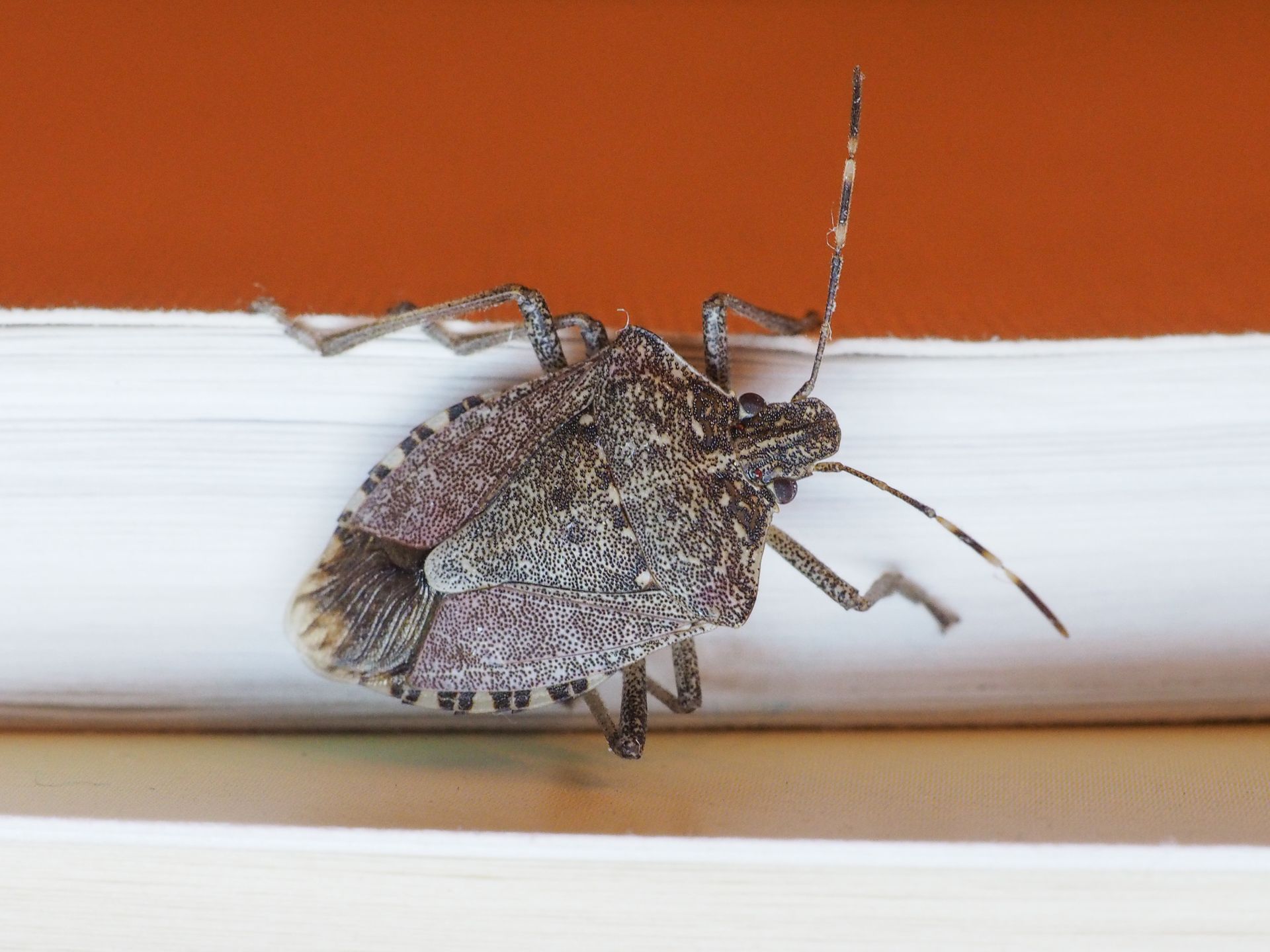Where Do Stink Bugs Come From?

Even though there are over 200 species of stink bugs that inhabit North America, the most prevalent species that is making the most impact is the brown marmorated stink bug. This species of stink bug is an invasive species that originated in East Asia before being brought to the United States in the late 1990’s. The first sighting was in Pennsylvania in 1998 where the brown marmorated stink bugs are thought to have crossed overseas in container ships before reaching the port in Pennsylvania. Since then, they have spread across the US and are now documented in 41 states. This is problematic because these insects are agricultural pests that cause a significant amount of damage to orchards, vineyards, and gardens and have very few natural predators to help keep their populations in check.
What Are Stink Bugs?
Stink bugs are a sap sucking insect that has a shield shaped body that is often covered in a brown and grey mottled pattern. They are typically about ¾ of an inch long and almost as wide as they are long. They have 6 legs, wings, and glands that produce chemical pheromones that can act as a defense mechanism or attractant for other stink bugs. When the stink bugs feel threatened, they will release an odor that is offensive to the sensitive noses of predators and acts as a deterrent. When they find somewhere they can hide safely, they will release an aggregation pheromone that attracts other stink bugs.
Stink bugs are typically active from late spring to late fall but when temperatures drop, the stink bugs will prepare to enter a hibernation phase called diapause. To ensure that stink bugs survive this period, they need to find somewhere protected and warm to hide. This often causes stink bugs to start moving indoors when temperatures drop. The problem that occurs when this happens is one stink bug will start to attract others until there are hundreds or thousands of stink bugs invading a space.
Where Did Stink Bugs Originate From?
Brown marmorated stink bugs are an invasive species in the United States. Stink bugs originated in Eastern Asia where they are native to Japan, China, Korea, and Taiwan. They were first documented in Pennsylvania in 1998 but are thought to have arrived at a US eastern port of entry much earlier than that. Stink bugs are flying insects that can travel long distances in search of food which is problematic because they have managed to spread far from where they originally arrived on the east coast. Since the late 1990’s, brown marmorated stink bugs have spread across the US to 41 other states, reaching as far west as California and as far south as Florida.
Why Are Stink Bugs a Problem?
Stink bugs are a devastating agricultural pest that can cause extensive damage to plant life and agriculture. Stink bugs prefer to feed on fruit trees, vegetable crops, and ornamental plants which result in damage to orchards, vineyards, and crop harvests. Stink bugs are sap suckers who use their proboscis to feed on the fluids found in leaves, stems, and fruits. This causes bruising and scarring that makes produce unsellable. They will feed on everything from apples, peaches, pears, figs, berries, citrus, corn, tomatoes, peppers, beans, and much more which costs farmers in America millions of dollars in losses every year. If that wasn’t enough of a problem, stink bugs are invasive which means they have no natural predators that can keep their populations under control, and they can release an aggregation pheromone that attracts other stink bugs. This means that one stink bug can potentially attract thousands of others with no natural control methods to rely on.
Where Did the Stink Bugs Inside My House Come From?
After spending most of the year outside feeding on agricultural plants, stink bugs will prepare for winter by looking for a place to hibernate. This will cause stink bugs to seek out warm places that they can hide when temperatures get cold. Unfortunately, stink bugs are also attracted to light so whenever there is a home close by, any lights left on at night will attract the stink bugs to your property. If the exterior lights lead stink bugs to a home, it’s a matter of time before they navigate their way inside through any access points they find. The real problem occurs once one stink bug has gained entry. Once a stink bug is inside, it will release a chemical pheromone that will indicate to other stink bugs of a safe place to hide. This will draw other stink bugs until a home is dealing with a full-blown stink bug infestation.
What Attracts Stink Bugs to Your Home?
There are several things that could potentially attract stink bugs to your home or building.
- Shelter during the winter: Stink bugs can’t survive where it is too cold so they need to find a warm undisturbed area they can hide safely for several months. This is typically in an out of the way place like attics, basements, crawl spaces, etc.
- Aggregation pheromones: Other stink bugs will release aggregation pheromones that will draw in other stink bugs.
- Exterior lighting: Stink bugs are attracted to bright white lights. This means that stink bugs will be drawn to a home if flood lights, or exterior lights are left on.
- Access points: Attraction doesn’t mean much without access. If a home has easy to find entry points, stink bugs will manage to find a way in.
- Agricultural food sources: Stink bugs need to find food sources to sustain themselves so having agricultural fields, fruit trees, or gardens will attract stink bugs.
- Natural building materials: Stink bugs are not naturally drawn inside; they just manage to find their way into places where it is warm. If a home uses natural looking materials, it is much more likely to attract stink bugs.
Are Stink Bugs a Threat?
For most people, stink bugs are a relatively neutral nuisance pest that will occasionally invade someone’s garden and home. They don’t present much of a threat to humans since they are not venomous and do not bite or sting. The biggest threat they present is their offensive smell. This odor is said to smell like cilantro and rotting fruit which isn’t too bad if only one stink bug is present. However, things are much different when you are dealing with several thousand stink bugs that have all decided to aggregate in a closed space. When this happens, it is important to not crush or kill them as they release even more of that scent when crushed. Instead, it is much better to collect them and discard them so they can’t come back in.
How to Get Rid of Stink Bugs
The best way to get rid of stink bugs depends on where they are found. Stink bugs that are discovered outside during the year should be sprayed with soapy water to knock them off a plant. The soapy water mix should hopefully be enough to deter the stink bugs from returning. If stink bugs are found inside during the winter, it is important to avoid crushing them to prevent the release of their odor. Instead use a vacuum cleaner to suck the stink bugs up and trap them inside of a sealable plastic bag before discarding them safely in the trash. Be sure to clean up any area where sting bugs were found to eliminate any traces of any aggregation pheromones left behind. Otherwise, stink bugs will just find their way back inside. If stink bugs have not been discovered, there are prevention strategies that may help deter stink bugs from becoming a problem. Be sure to:
- Seal access points: Stink bugs need entry points to find their way inside. Be sure to seal any cracks and crevices in siding, around pipes, and under fascia with caulking.
- Repair windows and doors: Windows and doors often leave gaps or have tears in screens that allow small bugs inside. Be sure to close any gaps and repair any torn screens.
- Turn off lights: White light attracts stink bugs so turning off exterior lights and minimizing the use of flood lights is a great way to reduce the likelihood of stink bugs finding your home.
- Keep exterior well maintained: Stink bugs need plant life to feed on. It may be impossible to eliminate all potential food sources but keeping a yard well maintained may at least reduce the likelihood of stink bug activity.
- Call a professional: Pest control professionals can curate a strategy designed to minimize pest activity including stink bugs.
Contact EcoGuard Pest Management if You Are Dealing with Stink Bugs
If you are dealing with a stink bug problem, it is time to bring in the professionals. EcoGuard Pest Management has a team of licensed and trained stink bug control experts standing by to assist with inspection, treatment, and on-going maintenance. We know where to look, what signs to look for, and how to effectively exterminate a stink bug problem. Call today to schedule an inspection with one of our stink bug control experts!

















